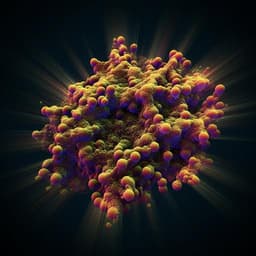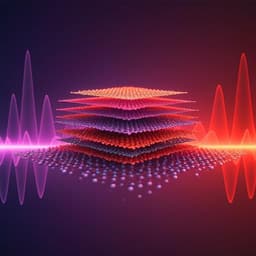
Physics
High-throughput screening of 2D materials identifies *p*-type monolayer WS₂ as potential ultra-high mobility semiconductor
V. Ha and F. Giustino
Discover the groundbreaking research by Viet-Anh Ha and Feliciano Giustino, revealing that monolayer WS₂ could be the next big thing in 2D semiconductors, potentially achieving room-temperature hole mobilities over 1300 cm²/Vs! This study uncovers how intricate calculations can predict mobility by considering factors like spin-orbit coupling and electron-phonon interactions.
~3 min • Beginner • English
Introduction
Continued CMOS scaling toward sub-nanometer channel thickness challenges silicon device performance due to mobility degradation from quantum confinement, surface roughness, and dangling bonds. 2D van der Waals semiconductors, with atomically sharp surfaces and monolayer-thick channels, offer a potential path forward by enabling reduced gate length and lower switching capacitance. Yet most 2D materials show low field-effect mobilities (typically 50–100 cm²/Vs) and high contact resistance due to the absence of surface dangling bonds and Fermi-level pinning from native defects and limited doping options. Prior computational searches for high-mobility 2D semiconductors often relied on simplified transport models (e.g., relaxation time approximation) and neglected spin-orbit coupling (SOC), limiting predictive accuracy. This study aims to: (i) establish a systematic high-throughput screening (HT) pipeline to identify high-mobility 2D semiconductors; (ii) provide reproducible ab initio mobility data for top candidates using the ab initio Boltzmann transport equation (aiBTE) with SOC; and (iii) explain the gap between intrinsic theoretical limits and experimentally measured mobilities, focusing on extrinsic scattering and interface effects. The Materials Cloud 2D database (MC2D), derived from experimentally realized layered parents, is leveraged to maximize experimental feasibility.
Literature Review
Previous computational efforts screened candidate 2D semiconductors for high mobilities but often used the relaxation time approximation, neglected SOC, or applied simplified scattering models. For example, studies identified several materials with estimated mobilities >1000 cm²/Vs but did not include SOC (except in limited cases) and used approximate scattering models. Phosphorene emerged as a promising n-type channel but suffers from ambient instability. Hexagonal antimonene (h-Sb) was predicted to exhibit very high hole mobility (>1300 cm²/Vs) within relaxation time approximations. Large databases such as the Materials Cloud 2D (MC2D) and the C2DB now allow systematic screening. Earlier MC2D-based screening omitted SOC for most compounds, whereas this work demonstrates SOC can dramatically alter effective masses and scattering pathways, especially for holes in transition-metal dichalcogenides (TMDs). Recent studies on thousands of C2DB entries proposed candidates with very high mobilities, but results depended strongly on model assumptions. This study advances the literature by: including SOC at screening and transport stages; using aiBTE with accurate long-range electron-phonon interactions (2D Fröhlich, and quadrupoles where relevant); and validating against known materials (e.g., MoS₂).
Methodology
High-throughput screening workflow: Starting from MC2D (5619 layered compounds), 1036 were labeled easily exfoliable (exfoliation energy <30 meV/ų). Dynamical stability (no soft phonons) yielded 258 monolayers; 166 non-metals (Set A). DFT calculations (PBE) without SOC provided band structures and conductivity effective masses at 300 K for 10¹² cm⁻² carriers. Down-selection retained compounds with either electron or hole conductivity mass <1 mₑ and 0.1 < Eg < 3 eV, yielding 95 compounds (Set B). Effective masses were then recomputed including SOC, and compounds with both electron and hole masses <1 mₑ were retained, giving 50 (Set C). For Set C, mobilities were estimated using: (i) a 2D Fröhlich polar-phonon model (found to give unrealistically high values for TMDs), and (ii) Emin’s formula (τ = ħ/kBT) to obtain order-of-magnitude estimates; 12 candidates with both electron and hole mobilities >100 cm²/Vs were selected for full transport (Set D). Full transport calculations: aiBTE with EPW code using Wannier-Fourier interpolation, SOC included throughout; long-range dipole (Fröhlich) e–ph interactions treated with exact 2D formalism; non-analytic quadrupole corrections included for WS₂. Transport computed at 300 K with dense k/q meshes (converged to <1 cm²/Vs) within ±300 meV of band edges. For WS₂, higher-level GW quasiparticle corrections (BerkeleyGW) refined band edges and effective masses. Additional scattering mechanisms: ionized-impurity scattering estimated via ab initio bulk formulation combined through Matthiessen’s rule as an upper bound for 2D; extended-defect scattering modeled via traversal-time approximation (τ ≈ L/|v|) with defect size L (10–500 nm). The methods isolate contributions from SOC, carrier concentration, quadrupoles, ionized impurities, and extended defects to reconcile theory with experiment. Codes: Quantum ESPRESSO/DFPT for DFT/phonons; EPW/Wannier90 for e–ph and aiBTE; BoltzTraP for conductivity effective masses; BerkeleyGW for GW; ABINIT for dynamical quadrupoles. 2D Coulomb truncation applied in DFT/DFPT. Parameters followed recommended pseudopotentials (SSSP, PseudoDojo) and convergence testing.
Key Findings
- Screening outcome: From 5619 layered candidates, 166 non-metal monolayers (Set A) were filtered by effective mass and gap criteria to 95 (Set B), then with SOC to 50 (Set C). Using Emin’s mobility estimates, 12 high-promise materials (Set D) were selected for aiBTE: Sb, GeSe, SnTe, ZrSe₂, HfSe₂, WS₂, WTe₂, SiH, Tl₂O, Bi₂Te₃Se₂ (skippenite), TiNCl, TiNBr. - Validated methodology on MoS₂ (10¹² cm⁻²): phonon-limited μh ≈ 104 cm²/Vs, μe ≈ 165 cm²/Vs at 300 K; consistent with prior theory and experiments. - Intrinsic mobilities at 300 K, low carrier density (10¹⁰ cm⁻²) unless noted: • WS₂: μh = 3021 cm²/Vs; μe = 225 cm²/Vs. • WSe₂ (added for comparison): μh = 967 cm²/Vs. • h-Sb (antimonene): μh = 1258 cm²/Vs; μe = 47 cm²/Vs. • Bi₂TeSe₂: μh = 95 cm²/Vs; μe = 361 cm²/Vs. • WTe₂: μh = 424 cm²/Vs; μe = 145 cm²/Vs. • GeSe: μh ≈ 50 cm²/Vs; μe ≈ 43 cm²/Vs. • SnTe: μh ≈ 180 cm²/Vs; μe ≈ 160 cm²/Vs. • ZrSe₂: μh = 45 cm²/Vs; μe = 15 cm²/Vs. • HfSe₂: μh = 35 cm²/Vs; μe = 13 cm²/Vs. • TiNCl: μh ≈ 98 cm²/Vs; μe ≈ 74 cm²/Vs. • TiNBr: μh ≈ 97 cm²/Vs; μe ≈ 97 cm²/Vs. • SiH (silicane): μh = 107 cm²/Vs; μe = 27 cm²/Vs. • MoS₂ (for comparison, 10¹² cm⁻²): μh ≈ 104 cm²/Vs; μe ≈ 165 cm²/Vs. - Mechanism for ultra-high μh in WS₂: SOC pushes Γ-valley 235 meV below K and splits K/K′ by 428 meV, suppressing K→Γ, intravalley interband, and intervalley K↔K′ hole-phonon scattering; acoustic phonons dominate with weak Fröhlich coupling. - WS₂ detailed numbers: • Without SOC: μh ≈ 99 cm²/Vs (10¹⁰ cm⁻²). • With GW at low density: μh ≈ 3309 cm²/Vs (≈10% above DFT). • At 10¹³ cm⁻² with GW: μh ≈ 2087 cm²/Vs; adding quadrupoles: μh ≈ 1342 cm²/Vs (intrinsic limit at high carrier density). • Adding ionized-impurity scattering at 10¹² cm⁻² defect density: defect-limited μh ≈ 819 cm²/Vs; combined via Matthiessen: ≈ 509 cm²/Vs. • Extended defects (L ≈ 30 nm): μh further reduced to ≈ 240 cm²/Vs; for larger L (500 nm) reductions are smaller. - Comparison with experiments: WS₂ electron mobilities reported 20–213 cm²/Vs; best ≈214 cm²/Vs closely matches aiBTE μe = 225 cm²/Vs. Reported hole mobilities 4–105 cm²/Vs can be rationalized by combined effects of high carrier density, quadrupoles, defects, extended defects, and contact resistance. - Other materials insights: ZrSe₂/HfSe₂ show strong Fröhlich coupling and low μ; TiNCl/TiNBr mobilities are much lower than prior deformation-potential estimates due to dominant LO optical phonon scattering; Bi₂TeSe₂ n-type is promising (μe ≈ 361 cm²/Vs). Overall, only a few compounds achieve very high intrinsic mobilities, with p-type mobilities (WS₂, WSe₂, h-Sb) notably exceeding top n-type values.
Discussion
The study addresses the key question of which experimentally accessible 2D materials can deliver high intrinsic room-temperature mobility suitable for advanced transistor channels, and why measured mobilities typically fall short. The HT pipeline, combined with rigorous aiBTE transport including SOC and long-range e–ph interactions, identifies WS₂ as an intrinsically ultra-high mobility p-type semiconductor and clarifies the microscopic mechanisms (SOC-induced valley energetics and spin textures) that suppress key scattering channels. The close agreement between computed and experimental electron mobilities in WS₂ and validated MoS₂ mobilities support the predictive accuracy of the approach. The large discrepancy between intrinsic μh predictions and reported p-type WS₂ mobilities is explained by extrinsic factors: higher carrier densities (increasing polar phonon emission), quadrupolar/piezoacoustic scattering, impurity scattering, extended defects (grain boundaries, ripples), contact resistance (Schottky barriers to high-ionization-energy WS₂), and dielectric environment (remote phonon scattering) that can substantially reduce mobility. These insights indicate that achieving the intrinsic limit requires co-optimizing material quality (defects, grain size), contact engineering (barrier-free p-contacts), and dielectric environment to mitigate remote phonon scattering. The results also demonstrate that simplified transport models are insufficient for quantitative screening; full ab initio treatments are essential to capture material-specific scattering physics.
Conclusion
- Main contributions: (i) A reproducible SOC-aware high-throughput pipeline from MC2D, down-selecting to realistic high-mobility candidates; (ii) state-of-the-art aiBTE transport for 16 materials with accurate 2D long-range e–ph interactions; (iii) identification of monolayer WS₂ as an intrinsically ultra-high mobility p-type semiconductor and mechanistic elucidation of SOC-driven scattering suppression; (iv) comprehensive reconciliation of theory and experiments by including GW, quadrupoles, impurity and extended-defect scattering, and discussing contact and dielectric effects. - Key outcome: Best theoretical estimate for intrinsic hole mobility in ideal suspended monolayer WS₂ at 300 K and 10¹³ cm⁻² carriers, including SOC, GW, and quadrupoles, is ≈1342 cm²/Vs. - Implications: P-type 2D channels (WS₂, WSe₂, h-Sb) can surpass n-type mobilities, revealing promising pathways for complementary logic if contacts and interfaces are optimized. - Future directions: Incorporate dynamic free-carrier screening of long-range e–ph couplings; explicitly model remote phonon scattering and plasmon-phonon polaritons in device-relevant dielectric stacks; include higher-order phonon processes (electron–two-phonon); develop improved 2D impurity-scattering formalisms; pursue experimental efforts on low-defect, large-grain WS₂ and barrier-free p-contacts (e.g., doped TMD contacts) to approach intrinsic limits.
Limitations
- Screening stages initially used DFT-PBE band structures and effective masses without SOC, followed by SOC inclusion only for down-selected sets; while mitigated by later SOC-accurate transport, early filters may miss edge cases. - aiBTE transport primarily includes electron-phonon scattering; for most materials, dynamical quadrupole corrections were not included (except WS₂), potentially underestimating scattering where Fröhlich coupling is weak. - Free-carrier screening of Fröhlich and quadrupole e–ph interactions was not included, which may overestimate long-range scattering at high carrier densities. - Ionized-impurity scattering was estimated using a bulk formalism and combined via Matthiessen’s rule as an upper bound; a full 2D-specific ab initio treatment is not yet available. - Extended-defect scattering was modeled with a simplified traversal-time approach (τ ≈ L/|v|), neglecting detailed defect physics. - Device-level extrinsic effects such as contact resistance and remote phonon scattering from gate dielectrics/substrates were discussed but not self-consistently included in the aiBTE framework. - Some mobility values depend on carrier density (10¹⁰–10¹³ cm⁻²); experimental conditions may differ, affecting direct comparisons.
Related Publications
Explore these studies to deepen your understanding of the subject.







